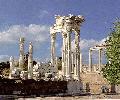| Pergamum... |
|
Pergamon was a small settlement during the Archaic Period. Lysimachos, who had become the sovereign of Anatolia after
301 BC, delivered the war expenditures, at the amount of 9000 talents, to Philetairos who was the commander of Pergamon,
and the kingdom founded by Philetar by using this sum of money following Lysimachos's death, flourished and became the
most eminent center of culture of the Hellenistic period during 150 years. Eumenes the I., Attales the I. and Eumenes the
II. were enthroned successively after Philetairos. Eumenes the II. took acropolis of Athens as an example and had the
acropolis of Pergamon adorned with works of art which reflected fine taste, and Pergamon became one of the most graceful
cities of the world. Attales the III. who succeeded Attales the II., handed over his land to in 133 BC. In Acropolis, the
remains that we see on the left hand side while entering the ruins, are the monumental tombs built for the kings of
Pergamon during the Hellenistic period. Shops are situated at their side. When we enter the Acropolis, the remains seen
at our left side, are the foundations of Propylon which Eumenes the II. had ordered to be constructed. Today, this Propylon
has been reconstructed at the Museum of Berlin. From here, we pass to a square surrounded with three stoas of the Doric
order. This is the abode of Sacred Athena, built during the time of Eumenes the II. The Temple of Athena built in the
3rd century BC, is just above the theater. The famous Library of Pergamon which contained 200,000 books, was
situated north of the square. As it is already known, Antonius had made a present of this library to Cleopatra. The remains
near the library, are the remains of houses belonging to the Hellenistic period. When we turn back and go up the stairs,
the remains of the palaces of Eumenes the II. and Attales the II. are seen. Towards the inside of the Acropolis, there are
houses, military barracks and, at the farthest end, there are military warehouses called "Arsenals". The building
that has been restored at present, is the Temple of Trajan. Emperer Hadrian (117-138) had this temple constructed in the
Corinthian order and it was placed upon a terrace with dimensions of 68 x 58 m. Attempts have been continuing since the
year 1976 to erect this temple which has 6 x 9 columns and a peripteros. The Theater of Pergamon, one of the steepest
theaters in the world, has the capacity to include 10,000 people and had been constructed in the 3rd century BC.
|
|

|






